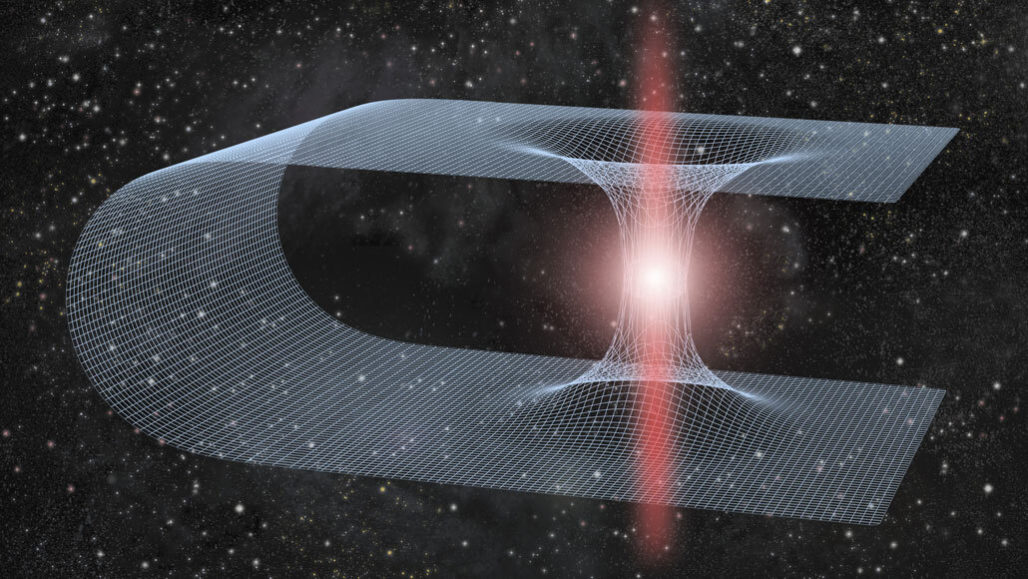Could ripples in spacetime point to wormholes?
Such tunnels in the fabric of space could show up via unusual gravity waves

A wormhole, illustrated here, is a tunnel through spacetime that connects different parts of the universe. Scientists report that a black hole circling a wormhole would emit a special pattern of gravitational waves — one unique to wormholes.
estt/iStock/Getty Images Plus
Gravitational wave detectors have already spotted mysterious black holes. But what they turn up next might be even stranger: wormholes.
Physicists have long suspected wormholes might exist. If wormholes exist, from the outside they might appear similar to black holes. But an object that falls into a black hole would become trapped inside it. In contrast, anything that falls into a wormhole should be able to pass right through to the other side.
The force we experience as gravity actually results from the curving of spacetime.
It can be hard to picture, so consider this: Planets orbit around the sun because the sun makes a bowl shape in the fabric of space. (The planets are a bit like marbles circling around and around inside that bowl.) Black holes curve spacetime into chasms so deep that nothing can escape. But spacetime could also curve into other weird shapes, such as tunnels.
These tunnels, or wormholes, would offer a shortcut between two distant sites in space and time or between two different universes.
Spacetime can curve, but it also can ripple. Those ripples are called gravitational waves, or sometimes gravity waves.
Scientists know how to detect these small tremors when two black holes swirl around each other and collide. There might also be patterns of gravity waves they haven’t seen yet. A black hole spiraling into a wormhole should create an odd pattern of ripples in spacetime. And with the right tools, certain observatories might be able to pick that up.
That’s the conclusion of a new July 17 report at arXiv.org. The waves from the black hole-and-wormhole pair would blink off and on as the black hole passed through the wormhole and then came back out again.
But are they real?
To be sure, no evidence yet exists for wormholes.
“These are speculative for sure, with a capital S,” says William Gabella. He’s a physicist at Vanderbilt University in Nashville, Tenn. However, he adds, if wormholes do exist, researchers should have a chance of detecting them. It would just take the right conditions and a gravity-wave detector.
Gabella is part of a team that wondered what ripples from a wormhole might look like.
That team considered a black hole with a mass five times that of the sun. They imagined it orbiting a wormhole about 1.6 billion light-years from Earth. As the black hole swings around the wormhole, they calculated, it should begin spiraling inward. This would release gravity waves. At first, these would look just like gravity waves from two black holes. The pattern of waves, called a chirp, would increase in frequency over time. But when it reached the wormhole’s center, or “throat,” the black hole would pass through.
The researchers then considered what would happen if the black hole emerged in a distant realm. For instance, it might come out in another universe. In that case, the gravitational waves in the first universe would abruptly end. In the second universe, the black hole would shoot outward before spiraling back in again. Then, it would pass back all of the way through the wormhole and into the first universe again.
As the black hole returned, it would initially spiral outward from the wormhole. This might produce an “anti-chirp” — a pattern of gravitational waves opposite to a chirp’s — before plunging back in with a chirp.
Over time, the black hole would continue bouncing between the two universes. This should cause repeated bursts of gravity waves. In between would be periods of silence. Once the black hole lost enough energy to those gravity waves, its journey would end as it settled down in the wormhole’s throat.
It all depends on those chirp detectors
“You can’t reproduce that [pattern] with two black holes,” says Dejan Stojkovic. “So it’s a clear-cut signal of a wormhole.” A physicist at the University at Buffalo in New York, Stojkovic was not involved with the new research. In the end, he says, the waves would be so unusual that their pattern “should be sticking [out] like a sore thumb.”
The general theory of relativity describes gravity as the result of the curvature of spacetime. And that theory suggests wormholes are possible. But actually detecting one would imply that there also exists some strange type of matter that physicists don’t understand. To keep a wormhole’s throat from collapsing, some substance with negative mass must prop it open. Right now, no known material could do that.
A few gravity-wave detectors now exist. Advanced LIGO is made up of two U.S. detectors. (Its acronym stands for Laser Interferometer Gravitational-Wave Observatory.) Another detector, in Italy, is known as Advanced Virgo. Both Advanced LIGO and Advanced Virgo detect ripples from black holes or from dense stellar corpses known as neutron stars.
Scientists are now skilled at spotting such mergers. They have confirmed more than a dozen. Even more await confirmation. But at some point, physicists will need to start focusing on more unusual possibilities, says Vítor Cardoso. He’s a physicist at Instituto Superior Técnico in Lisbon, Portugal. Says Cardoso: “We need to look for strange but exciting signals.”







